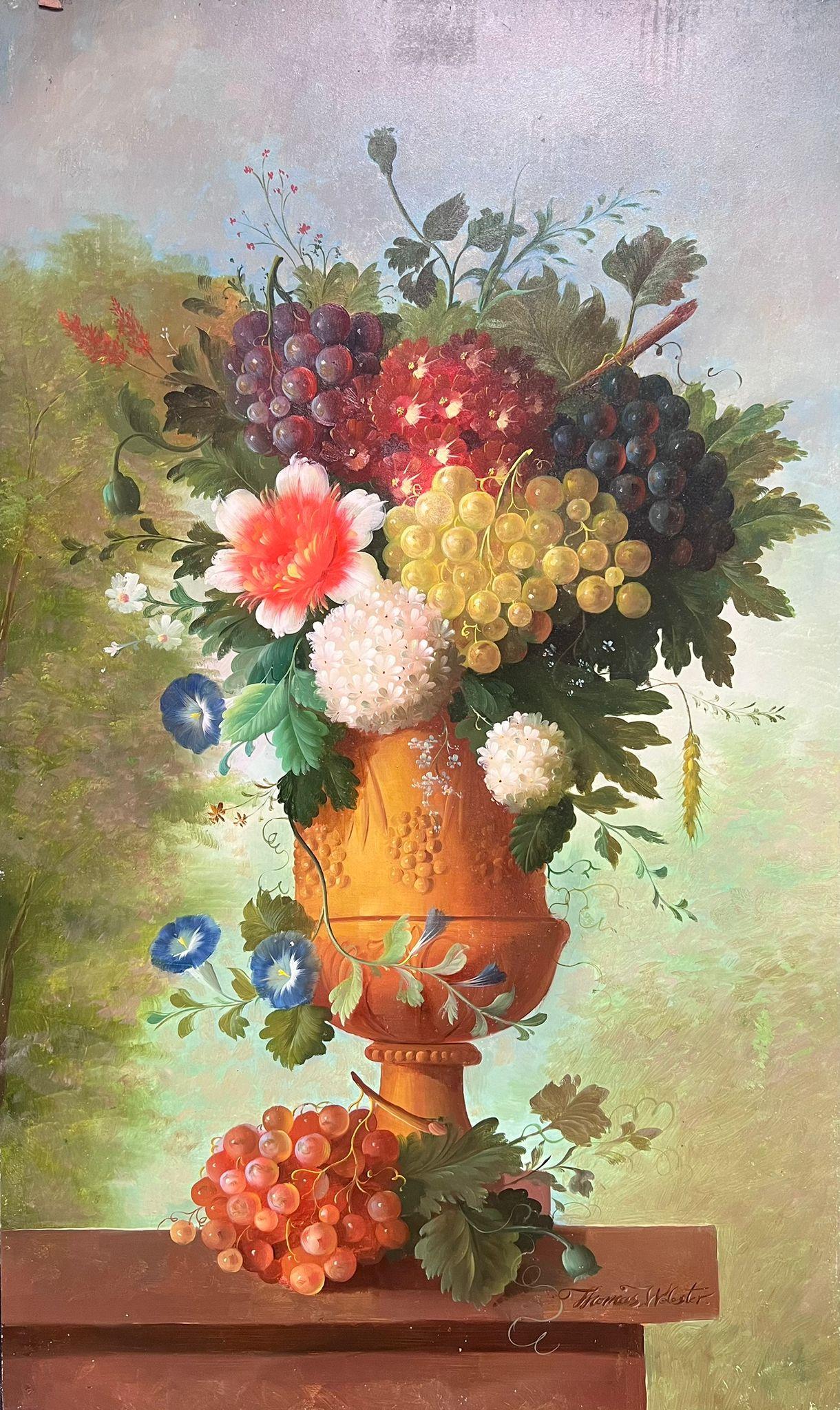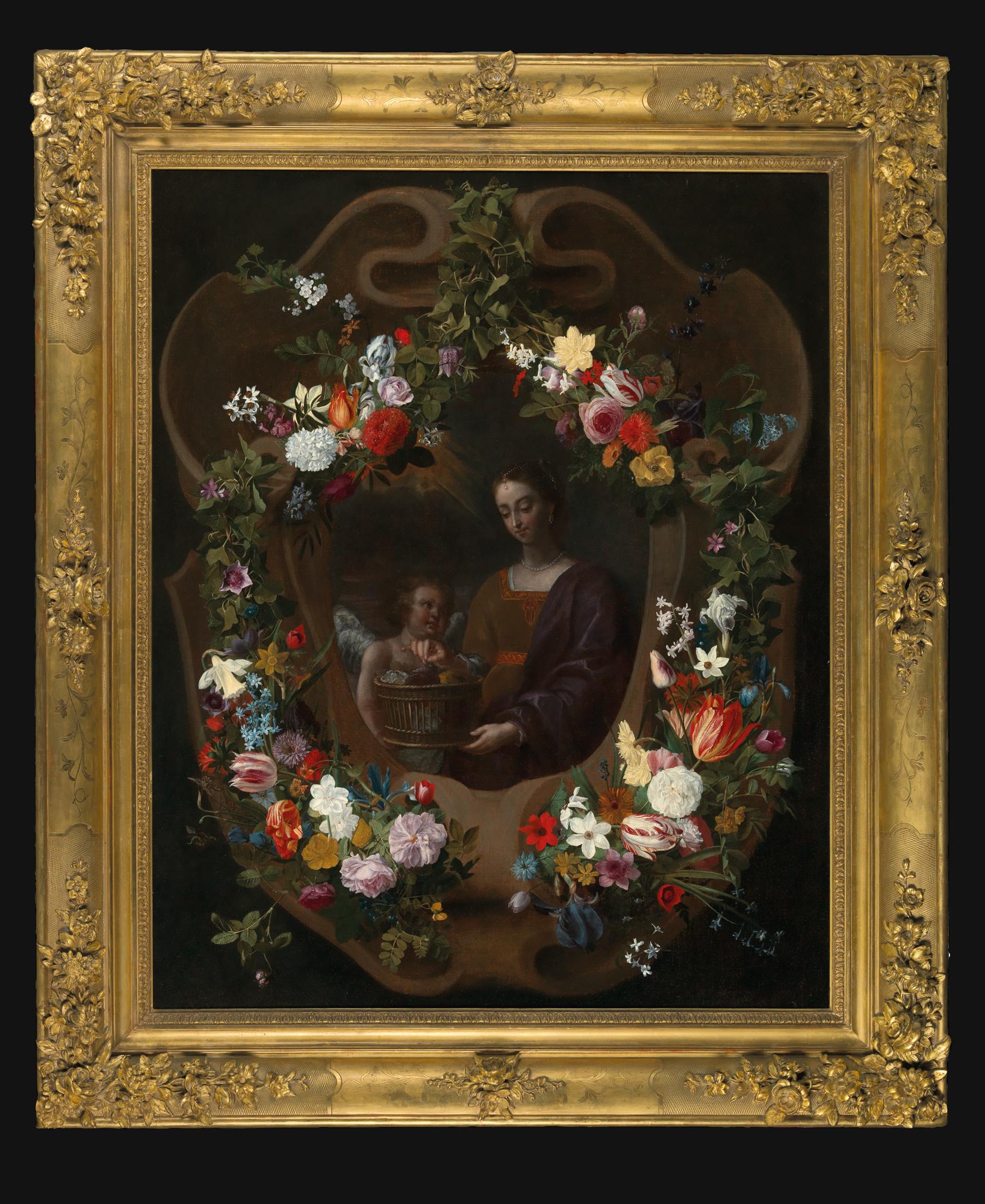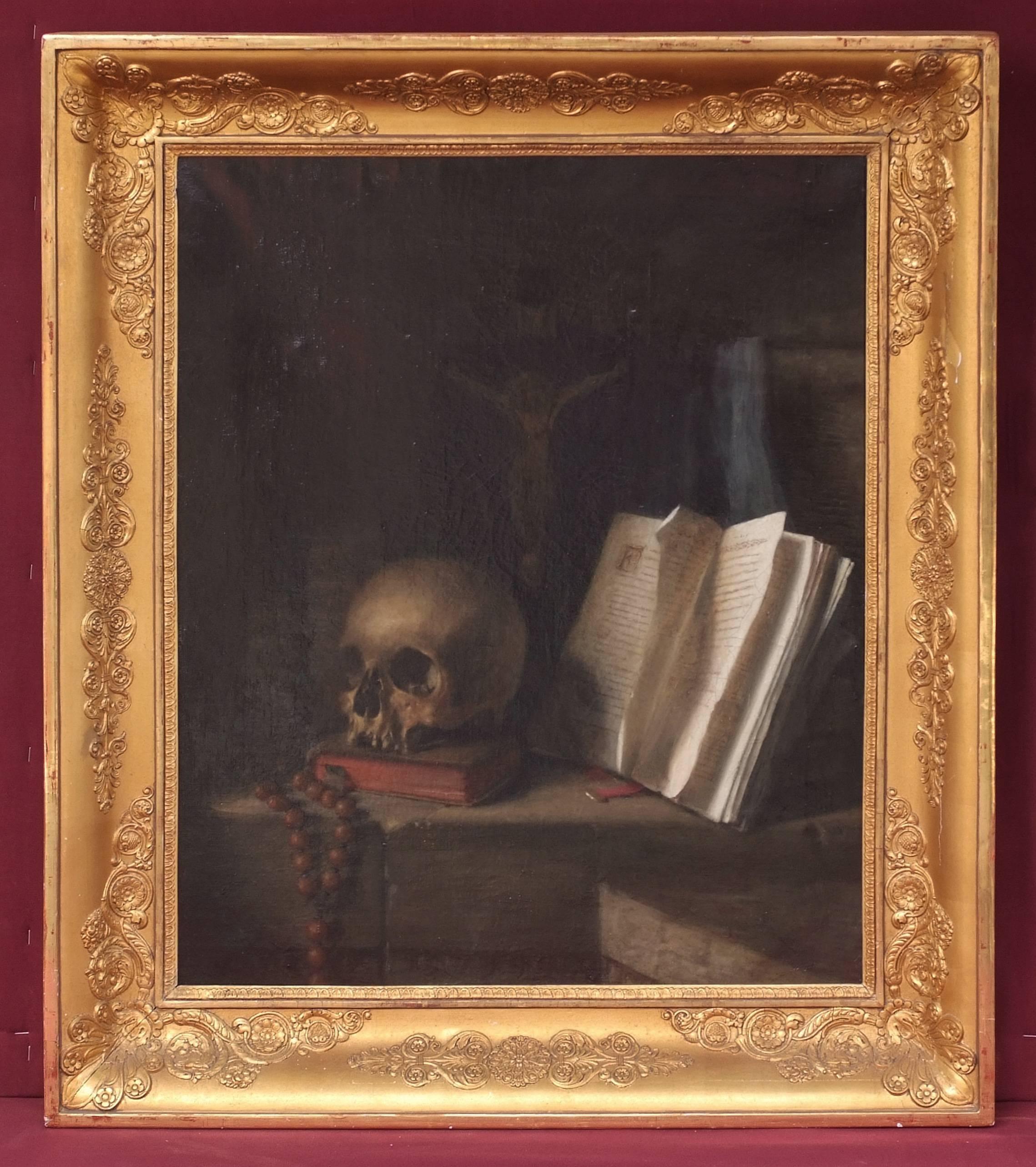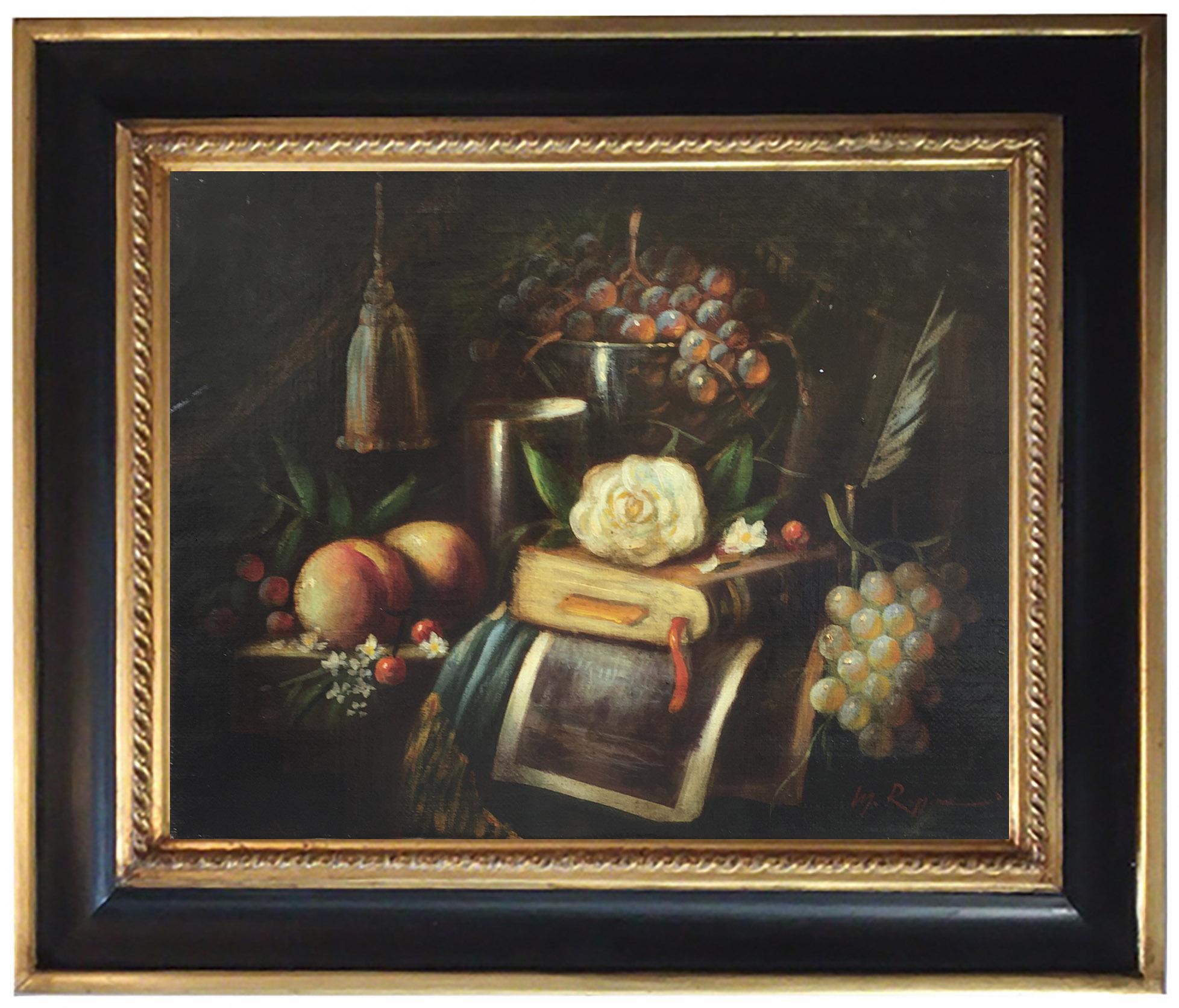Items Similar to A still life of flowers in an urn with a parrot, melon, pomegranates and figs...
Want more images or videos?
Request additional images or videos from the seller
1 of 4
Aniello Ascione (Naples, news from 1680 to 1708)A still life of flowers in an urn with a parrot, melon, pomegranates and figs...
About the Item
Aniello Ascione (Naples, fl. 1680-1708)
A still life of flowers in an urn with a parrot, melon, pomegranates and figs at its base, a view to an ornamental garden beyond
Oil on canvas
59 3/4 x 39 3/4 in
Provenance
The Alexander Family Collection, Milford House, Co. Carlow, Ireland
The latter half of the 17th century and earlier 18th century marked the golden age of Neapolitan still-life painting and Aniello Ascione was one of its most highly regarded exponents. His sumptuous paintings, brimming with fecund produce of the Mediterranean and painted in rich colours, were eagerly sought after by those who wished to decorate their palaces in that city.
Naples in the seventeenth century had established a significant reputation and artistic tradition of producing flamboyant and technically excellent still-lifes which had largely been initiated by Caravaggio who, having stated that it required as much effort to paint a good flower piece as a figure subject, helped to revolutionise and eventually abolish the closed attitude to genres of painting. Caravaggio maintained that art was the mirror of nature and his superb Basket of Fruit, now in the Ambrosiana in Milan and painted in 1597, marked the birth of European still-life painting. Throughout the 17th century, Neapolitan still-life painting was founded on the principles demonstrated by Caravaggio and these artists seem to have been the only ones to correctly understand and utilise his ideas. These paintings were noted for their vibrant portrayals of flowers, often in great abundance, fruit and birds done in an elegant and decorative manner.
Luca Forte (c.1615- c.1670) was one of the first Neapolitan artists to adopt the Caravaggesque naturalism in this genre of painting and with exceptional creativity sweeping through the city in the 1630s, he was soon followed by Paolo Porpora and Guiseppe and Giovanni Battista Recco and the Ruoppolo family. When Abraham Brueghel arrived in Naples in about 1670, his influence accelerated the transition of the portrayal of still-life to a more baroque style often epitomised by a mass of flowers, cascading over classical objects like water.
This more baroque style was taken up by a new generation of painters and one of the first and most prominent of these was Andrea Belvedere (1652-c.1732). He taught Nicola Casissa and other artists working in a similar vein included Gasparo Lopez (called Gasparo di Fiori) d. circa 1732, Paolo Porpora (1617-1663) and Nicola Malinconico (1663-1721). The aforementioned Ruoppolo family were also eminent and Giovan Battista Ruoppolo (1619-1693) instructed the young Aniello Ascione. His pupil became one of the most celebrated representatives of Neapolitan Baroque which combined the traditional naturalism favoured by the city with the new 18th century decorative style. This style proved highly popular with the more secular Neapolitan middle classes as well as the aristocracy and royalty to furnish their grand homes. They loved the harmonious colouring and composition suffused with exuberance
Ascione became the most prominent still-life painter in Naples at the transition from the seventeenth and eighteenth centuries. His paintings, which are often of a significant size, utilise intense decorative colours with an abundance of flowers and piles of fruit such as pomegranates, grapes, peaches, pears, melons and plums. Sometimes these spill down stone steps or are draped or stacked with flowers among classical statuary and there is often a view to a landscape or ornamental garden beyond to give the composition depth. Accompanying the fruit and flowers, Ascione occasionally added parrots, dogs or rabbits and he often signed with a monogram comprised of interlocking As although there are some works signed in entirety. His smaller pieces tended to be more intimate in construction with one looking at just different fruits with some of its foliage so that the different hues and skin textures could interact and to some extent, these reflect the legacy of Abraham Brueghel. One very rare piece, now in the Castellino collection in Naples, is a kitchen interior with a skinned lamb which owes its influence to Guiseppe Recco.
There is a fine set of the Four Seasons, which also incorporates putti into the compositions and which are believed to have been contributed by Nicola Vaccaro (1659-1720) the son of Andrea Vaccaro, which is at the Museo Correale in Sorrento and there are two large canvases in Ursino Castle in Cenzato. The painter and art historian Bernardo de Dominici (1683-c.1759) who wrote biographies of Neapolitan artists earning him the sobriquet of the Neapolitan Vasari says of him: “…ha fatto molte opere di frutti e fiori, ma per lo più frutte, e l’uva erano la sua applicazione e con decoro ha l’arte esercitata, facendoli ben riconoscere delle sue fatiche e mantenendo il decoro della professione, ha con esse rese adorne varie gallerie de’signori ed altre stanze di particolari e da tutti son tenute in pregio l’opere sue”.
- Creator:Aniello Ascione (Naples, news from 1680 to 1708) (1680 - 1720, Italian)
- Dimensions:Height: 59.75 in (151.77 cm)Width: 39.75 in (100.97 cm)
- Medium:
- Movement & Style:
- Period:
- Condition:
- Gallery Location:Stoke, GB
- Reference Number:1stDibs: LU446311503342
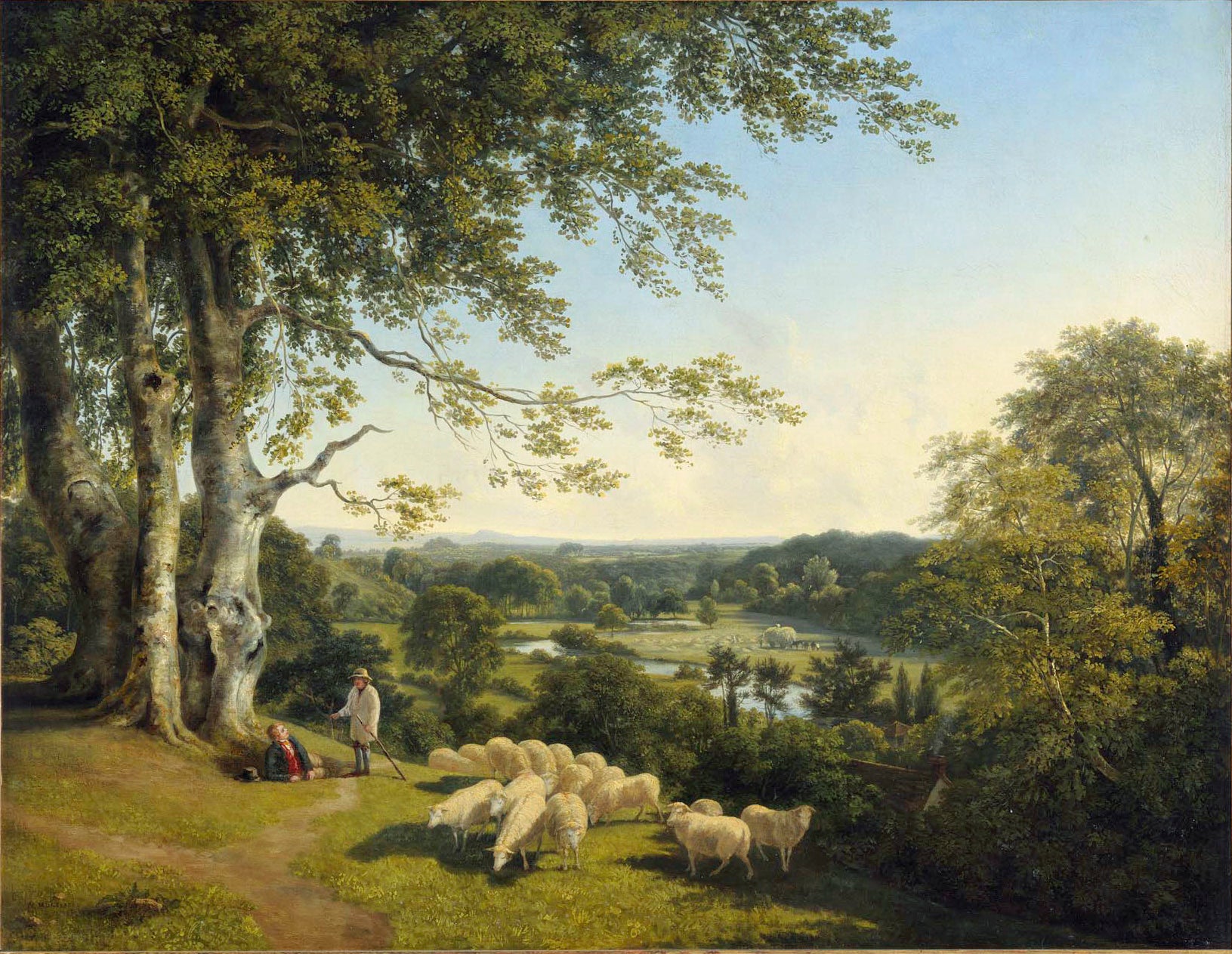
About the Seller
5.0
Recognized Seller
These prestigious sellers are industry leaders and represent the highest echelon for item quality and design.
Gold Seller
These expertly vetted sellers are highly rated and consistently exceed customer expectations.
Established in 2009
1stDibs seller since 2016
147 sales on 1stDibs
Typical response time: 2 hours
Associations
LAPADA - The Association of Arts & Antiques DealersInternational Confederation of Art and Antique Dealers' AssociationsThe British Antique Dealers' Association
- ShippingRetrieving quote...Ships From: Andover, United Kingdom
- Return PolicyA return for this item may be initiated within 2 days of delivery.
More From This SellerView All
- A German Pointer with hunting EquipmentLocated in Stoke, HampshireGerman School (18th century) A German Pointer with hunting Equipment Oil on canvas Canvas Size 42 x 35 in Framed Size 48 x 41 inCategory
18th Century Old Masters Animal Paintings
MaterialsOil
- Still life of fruit and nutsLocated in Stoke, HampshireJames Shaw (fl.1769-1784) Still life of fruit and nuts Oil on canvas Canvas Size - 13 1/2 x 17 3/4 in Framed Size - 16 1/4 x 20 1/2 in Born in Sedgley in Staffordshire, it is unclea...Category
18th Century Old Masters Still-life Paintings
MaterialsOil
- Still life of fruit on a woodland bankLocated in Stoke, HampshireG Gray (Early 19th Century) Still Life of Fruit Oil on panel Signed Painting Size 17.5" x 20" (44.4 x 50.8cm) Framed Size 23 x 26 inCategory
Early 19th Century Victorian Still-life Paintings
MaterialsOil
- Still Life of a Copper Pan and Pewter JugBy François BonvinLocated in Stoke, HampshireFrancois Bonvin (1817-1887) French Still Life of a Copper Pan and Pewter Jug Oil on Canvas Indistinctly Signed 9.5” x 16” (24 x 40.7cm) Bonvin was bor...Category
19th Century Still-life Paintings
MaterialsOil
- View of Shipping on the River Avon from Durdham Down, near BristolLocated in Stoke, HampshireThomas Smith of Derby (c. 1710-1767) View of Shipping on the River Avon from Durdham Down, near Bristol, 1756 Oil on canvas Canvas size - 20 x 47 in Framed size - 26 x 53 in Provena...Category
18th Century Old Masters Landscape Paintings
MaterialsOil
- Portrait of a gentleman, traditionally identified as Thomas CareyBy Paul II van SomerLocated in Stoke, HampshireCircle of Paul van Somer (Antwerp c. 1577-1621 London) Portrait of a gentleman, traditionally identified as Thomas Carey (1597-1634), youngest son of Thomas, 1st Earl of Monmouth Oil...Category
17th Century Old Masters Portrait Paintings
MaterialsOil
You May Also Like
- 18th Century by Francesco Lavagna Pair of Flower Vases Oil on CanvasLocated in Milano, Lombardia98 x 36 cm each without frame - 112 x 50 cm with frame Antique gilded and shaped wooden box frames Expertise by Prof. Giancarlo Sestieri This marvellous pair of flower vases has b...Category
Early 18th Century Old Masters Figurative Paintings
MaterialsCanvas, Oil
- Huge Classical Still Life Flowers & Fruit Still Life in Stone Urn Oil PaintingLocated in Cirencester, GloucestershireProfusion of Flowers by Thomas Webster, British contemporary artist, late 20th century signed oil on board, unframed board: 30 x 18 inches provenance: private collection, UK conditi...Category
Late 20th Century Old Masters Still-life Paintings
MaterialsOil
- Very Large Profusion of Flowers Classical Still Life Stone Urn Oil PaintingLocated in Cirencester, GloucestershireClassical Still Life of Flowers by Thomas Webster, British contemporary artist late 20th century signed oil on board, unframed board: 30 x 18 inches provenance: private collection, U...Category
Late 20th Century Old Masters Still-life Paintings
MaterialsOil
- Grand-Scale Old Master Garland Portrait, 17th Century, Signed & Dated, Rare workLocated in London, GBIndistinctly signed and dated In the first quarter of the 17th century a new form of flower painting was developed in Flemish painting, which, recreated by a large group of artists and workshops, would achieve considerable success throughout the century in much of Europe: the garland of flowers surrounding a central figure. Brueghel de Velurs was the initiator of this type of composition, however, it was his pupil, Daniel Seghers, who was the dominant figure in this specialised production and the creator of a prototype that would serve as a model for the numerous artists who followed in his wake. It seems undeniable that the artist of the present painting had seen the Garlands of Flowers Surrounding a Medallion Depicting the Triumph of Love by Daniel Seghers and Domenico Zampieri (now in the Musée du Louvre in Paris). In our painting, the present floral wreath encircles a carved cartouche within which sits Saint Dorothy of Caesarea and the attribute which often accompanies her in art, a basket of roses. The extremely delicate flowers have been rendered in meticulous detail, so that every species can be identified from exotic tulips to roses, irises and forget-me-nots; this obvious attention to naturalism is inherited from the Flemish manner. Each flower is so precise and refined that they are an individual study in their own right. The still-lifes are from the hand of Jan Anton van den Baren, with the central figures by another accomplished hand. Van den Baren’s arrangement of flowers would have delighted connoisseurs in both Flanders and in Vienna, where the impossibility of their all blooming at the same time of year would have been understood as a further statement of the wonder and beauty of the divine. Van den Baren worked first in Brussels, where he collaborated with Erasmus Quellinus II for the figures in his works, before moving with Archduke Leopold Wilhelm, his patron, to Vienna in 1656, where he instead worked with fellow Flemish émigré painter Nikolaus van Hoy. The iconography relates to an eighth century legend where she was presented a basket of roses by a child. In addition to the brilliance of his handling of still-lifes Van den Baren played an important art historical role as Director of Archduke Leopold Wilhelm’s Picture Gallery in Vienna, then one of the greatest collections in the world and the core of what was to become the present collection of the Kunsthistorisches Museum, Vienna. Van der Baren compiled an inventory of the collection in 1659, and his predecessor as Director of the Archduke’s Picture Gallery (when it was still housed in Flanders), David Teniers, depicted van der Baren (third from right) in his celebrated Archduke Leopold Willem in his gallery at Brussels, conserved at the Kunsthistorisches Museum. It is a shining example of the Flemish Baroque and is a very rare object indeed, considering there are only 14 paintings accepted as authentic works by this artist. We are grateful to Fred Meijer for confirming the attribution to Johannes Antonius van der Baren. A feature of this painting is its outstanding carved and gilded frame with a plethora of flowers and foliage. Titan Fine ArtCategory
17th Century Old Masters Portrait Paintings
MaterialsCanvas, Oil
- Painting 18th Century Vanitas Still Life Skull Religion Esotericism OccultLocated in Saint-Ouen, FRVanitas 18th century French School Oil on canvas Old frame gilded with gold leaves Dim canvas : 73 X 60 cm Dim frame : 93 X 80 cm Certificate of authenticityCategory
Late 18th Century Old Masters Still-life Paintings
MaterialsOil
- STILL LIFE - Massimo Reggiani - Oil on Canvas Italian PaintingBy Massimo ReggianiLocated in Napoli, ITSTILL LIFE - Oil on canvas cm. 40x50 by Massimo Reggiani, Italy 2005 Still life, a pictorial representation of foodstuffs, objects or inanimate objects, was one of the artistic genres that became completely independent in the seventeenth century. Reggiani has composed this still life inspired by the Dutch school. Fruit, grapes and peaches...Category
21st Century and Contemporary Old Masters Still-life Paintings
MaterialsCanvas, Oil
Recently Viewed
View AllMore Ways To Browse
Life Size Figure
Large Antique Still Life
Old Master Flowers
Still Life Birds Paintings
Bird And Still Life Painting
Kitchen Still Life
Still Life 17th Century
Still Life 18th Century
Four Ages Of Love
Provence Still Life
Still Life Fruit Flowers
Still Life Fruit And Flowers
Old Master Flower Painting
Fig Art
Still Life Kitchen Art
Draped Flowers
Old Oil Paintings Still Life Flowers
Pomegranate In Art

